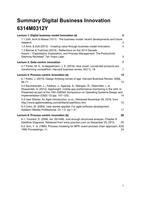Summary Digital Business Innovation
6314M0312Y
Lecture 1: Digital business model Innovation (a) 2
1.1 Zott, Amit & Massa (1011) - The business model: recent developments and future
research. 2
1.2 Amit, & Zott (2012) - Creating value through business model innovation. 4
1.3 Benner & Tushman (2015) - Reflections on the 2013 Decade
Award—“Exploitation, Exploration, and Process Management: The Productivity
Dilemma Revisited” Ten Years Later. 5
Lecture 3. Data-centric innovation 7
3.1 Porter, M. E., & Heppelmann, J. E. (2016). How smart, connected products are
transforming competition. Harvard business review, 92(11), 18. 7
Lecture 5: Process-centric innovation (a) 12
5.1 Kolko, J. (2015). Design thinking comes of age. Harvard Business Review, 93(9),
66-71. 12
5.2 Ravindranath, L., Padhye, J., Agarwal, S., Mahajan, R., Obermiller, I., &
Shayandeh, S. (2012). AppInsight: mobile app performance monitoring in the wild. In
Presented as part of the 10th USENIX Symposium on Operating Systems Design and
Implementation (OSDI 12) (pp. 107-120). 14
5.3 User Stories: An Agile Introduction. (n.d.). Retrieved November 26, 2016, from
http://www.agilemodeling.com/artifacts/userStory.htm 15
5.4 Cohn, M. (2004). User stories applied: For agile software development.
Addison-Wesley Professional. Ch 1-2, pp 1-41 17
Lecture 6: Process-centric innovation (b) 20
6.1. Yourdon, E. (2006, rev. 051406). Just enough structured analysis. Chapter 9:
Dataflow Diagrams. Retrieved from www.yourdon.com on December 20, 2015. 20
6.2. Kim, Y. G. (1995). Process modeling for BPR: event-process chain approach. ICIS
1995 Proceedings, 11. 24
1
, Lecture 1: Digital business model Innovation (a)
1.1 Zott, Amit & Massa (1011) - The business model: recent developments and future
research.
Despite the overall surge in the literature on business models, scholars do not agree on
what a business model is. As a result, cumulative progress is hampered.
The literature is developing largely in silos. The main interest areas identified are:
1. E-business and the use of information technology in organizations = e-business
model archetype
○ understanding of firms engaging in (new) Internet-based ways of doing
business and the (new) roles that these firms play in their respective
ecosystems.
○ Defined and represented generic (e-)business models
○ Typologies and taxonomies are developed
Definition: the business model is a value proposition, a revenue model, and a
network of relationships by itself.
- Value (e.g., value stream, customer value, value proposition)
- Financial aspects (e.g., revenue streams, cost structures)
- Architecture of the network between the firm and its exchange partners
(e.g., delivery channels, network relationships, logistical streams,
infrastructure).
2. Strategic issues (value creation, competitive advantage, and firm performance) =
business model as activity system
○ Networked nature of value creation
○ Relationship between business models and firm performance
○ Distinction between the business model and other strategy concepts.
What a business model is (not):
- Does not involve a linear mechanism for value creation from suppliers to
the firm to its customers.
- Value creation through business models involves a more
complex, interconnected set of exchange relationships and
activities among multiple players.
- Not the same as product market strategy (i.e., it does not refer to firm
positioning in product markets based on differentiation or cost leadership
in certain activities) or corporate strategy (i.e., it does not describe or
prescribe the areas of business in which a firm becomes active).
- Cannot be reduced to issues that concern the internal organization of firms
(e.g., control mechanisms, incentive systems); activity systems, even
though centered on a focal firm, typically span firm boundaries. However,
the business model can be a source of competitive advantage.
2




